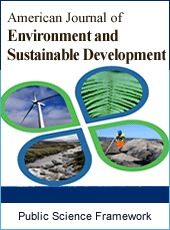American Journal of Environment and Sustainable Development
Articles Information
American Journal of Environment and Sustainable Development, Vol.5, No.2, Jun. 2020, Pub. Date: Jun. 10, 2020
Implication of Climate Change on Rice Production in Nyanza District of Rwanda
Pages: 24-29 Views: 2056 Downloads: 578
[01]
Gustave Nzungize, Faculty of Environmental Studies, University of Lay Adventists of Kigali (UNILAK), Kigali, Rwanda.
[02]
Hakizimana Narcisse, Faculty of Environmental Studies, University of Lay Adventists of Kigali (UNILAK), Kigali, Rwanda.
[03]
Muvunyi Jean Damascene, Faculty of Environmental Studies, University of Lay Adventists of Kigali (UNILAK), Kigali, Rwanda.
[04]
Lamek Nahayo, Faculty of Environmental Studies, University of Lay Adventists of Kigali (UNILAK), Kigali, Rwanda.
Climate change, one of the challenges facing the world today, is increasingly affecting people’s livelihood in Rwanda like other developing countries. This study aimed to assess the impact of climate change on rice production in Nyanza district, Southern Rwanda. The climate data mainly rainfall and temperature were obtained from Rwanda Meteorological Agency (RMA). The data on rice production were collected from the rice production cooperative in Nyanza district. The employed seven-year (2010-2017) datasets were analyzed by using the Statistical Package for Social Sciences (SPSS), Microsoft excel and Stata. The results indicated that the highest quantity of rice was produced in 2016 (6,254 tons) and 2017 was the year with the lowest rice production (2,809 tons). Regarding rainfall, the highest average was recorded in 2013 and 2016 (126.59-142.56 mm), and these years recorded rice productions of 5,350-6,254 tons, respectively. The temperature manifested a slight change with nearly 2°C between the lowest 20.5°C and the highest 22.44°C. The results indicated that change on average annual rainfall and temperature lead to 64.5% and 4.9% variations on annual rice production, respectively. Thus, rainfall significantly impacts on rice production in Nyanza District. Therefore, rice varieties resisting to climate change, mainly rainfall variability would be productive in this area.
Climate Change, Rice Production, Nyanza District, Rwanda
[01]
Bazzaz, F. A, Fakhri A, Sombroek, Wim G. (1996). Global climate change and crop production: Food and Agriculture Organization of the United Nations; Chichester; New York: Wiley
[02]
FAO. 2018. “The status of food security in the world.” Rom, Italy
[03]
IPCC, (1995). Climate change: a glossary by the Intergovernmental Panel on Climate Change. Available at: www.ipcc.ch/pdf/glossary/ipcc-glossary.pdf.
[04]
Chang &Derados (2006). Impact of climate change on rice and adaptation strategies, report submitted to the Economic and Planning Unit (EPU), Prime Minister’s Department, Putrajaya, Malaysia
[05]
Hazall, (1984). The economic impacts of climate change on rice production in Malaysia. International Journal of Agricultural Research, 6, 67-74.
[06]
Boo, K (2004a), Response of global warming on regional climate change over Korea: An experiment with the MM5 model, Geophys. Res. Lett., 31 (21), L21206,
[07]
Michel at all, (2007). Global climate changes and rice food security. IRC Report, 24-31.
[08]
Mc. Carthy et al, (2001). The potential of non-granary areas as a national source of rice production, proceeding at the Rice National Conference, Sunway Carnival Convention, 10-12 December.
[09]
FAO. 2014. “Adapting to Climate Change through Land and Water Management in Eastern Africa.” Rome, Italy.
[10]
L. NAHAYO, (2018). Rainfall variability and its impact on rainfed crop production in Rwanda.
[11]
Man Keen Kim (1999). Simulated impact of climate change on rice production in Peninsular Malaysia. Proceedings at National Conference on Climate change, University of Putra Malaysia, 41-49.
[12]
NISR. 2012. EICV3 District Profile South - Nyanza. 2010/11 Integrated Household Living Conditions Survey (EICV3). National Institute of Statistics of Rwanda. Kigali, Rwanda.
[13]
Nyanza District (2018): District development Strategy 2018-2024
[14]
Zhang T, Huang Y, Yang X (2013) Climate warming over the past three decades has shortened rice growth duration in China and cultivar shifts have further accelerated the process for late rice. Glob chang biol 19: 563-570.
[15]
S. Ceccareli, et al. (2010). Plant breeding and climate changes, Journal of Agricultural Science 148, 627-638
[16]
Warner et al. 2015. “Climate Change Profile: Rwanda
[17]
Popova Z, K. M. (2005). "CERES model application for increasing preparedness to climate variability in agricultural planning-risk analyses." Phys Chem Earth 30 (117): 24.
[18]
Kang, Y., S. Khan, et al. (2009). "Climate change impacts on crop yield, crop water productivity and food security-A review." Progress in Natural Science 19 (12): 1665-1674.

ISSN Print: Pending
ISSN Online: Pending
Current Issue:
Vol. 6, Issue 4, December Submit a Manuscript Join Editorial Board Join Reviewer Team
ISSN Online: Pending
Current Issue:
Vol. 6, Issue 4, December Submit a Manuscript Join Editorial Board Join Reviewer Team
| About This Journal |
| All Issues |
| Open Access |
| Indexing |
| Payment Information |
| Author Guidelines |
| Review Process |
| Publication Ethics |
| Editorial Board |
| Peer Reviewers |


